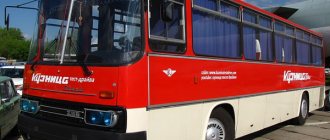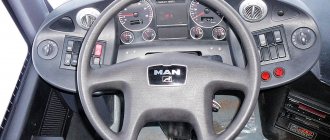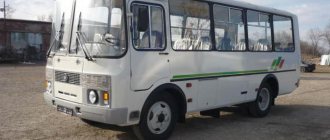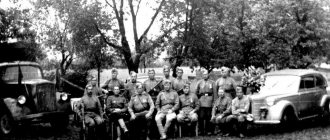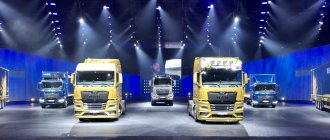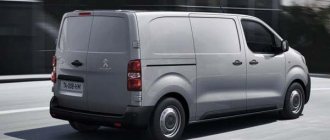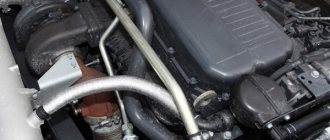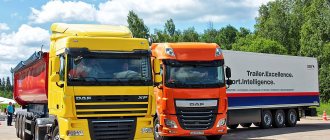Star in the Czech sky
Mikhail Sokolov, photo by Škoda, V. Tkachenko, A. Novikov and the author
These Skoda buses, which appeared 60 years ago, flashed as a bright star in the sky of passenger transport not only in Czechoslovakia, where they were created, but also in Poland, Bulgaria and other countries of the socialist camp. And although they came to the Soviet Union in limited quantities, they left a good memory of themselves here too.
In 1895, in the picturesque town of Vysoke Mýto in the East Bohemian region, Josef Sodomka's workshop was founded, which initially employed only five people. The production program included carriages and sleighs, and as motorization developed, automobile bodies also appeared. Passenger cars with bodies of their own production in Vysoké Mýto began to be produced in the 1920s, and soon production workers began to work on bus designs.
However, the heyday of bus production came only 30 years later - in the 1950s, when production of the Škoda 706RO wagon bus with a combined body made of wood and metal began. After some time, this model was replaced by the modernized and very successful Škoda 706RTO bus, which became very popular and was in use in some countries until the mid-1980s. These buses will be discussed.
"Seven hundred and six"
The Škoda 706 truck chassis was developed and produced in pre-war times. In particular, the 706D variant went into production in 1940. Such diesel trucks were produced in limited quantities and served as the basis for small-scale production of bonneted buses.
A new stage for the model began in 1945–1946, when a modernized version of the Škoda 706R, designed for 7.5–9 tons of cargo and equipped with a more powerful 145-horsepower 11.78-liter diesel engine, entered the Prague assembly line.
Among the modifications of the bonneted 706R, a chassis for the Škoda 706RO coach bus, developed in Vysoké Mýto, was soon added, at the same plant, which was transformed into the state-owned Karosa plant in the 1940s. From 1952 to 1958, these trucks and buses were assembled by the LIAZ plant located in the Liberec region of Czechoslovakia. Buses of the 706RO family were divided into passenger (city and intercity) and various vans with bus bodies without windows with overall dimensions of 10,660x2500x3060 mm and an internal cabin height of 1900 mm.
The curb weight, for example, of the tourist-excursion version of the 1955 model was 9400 kg, and the total weight was 14,000 kg. The already mentioned 6-cylinder diesel engine with 137 hp. at 1800 rpm (in the bus version) it was located in the front part of the body and was covered with a special soundproof cover. This required moving the front door back (as on the domestic ZIS-155 and LiAZ-158). The bus was equipped with a pneumatically driven braking system and a device for effective engine braking.
By that time, the body frame was already made of light steel profiles, and the cladding was made of millimeter-thick steel sheets.
The bus was equipped with soft seats, and in the backs there were small compartments for books and magazines. All metal parts inside the bus were chrome or aluminum.
The interior was ventilated through four hatches in the ceiling. In addition, when the heating system was operating, the air passing through it provided additional ventilation. The bus has two heating systems independent of each other. The water one was structurally connected to the engine cooling system and provided heating for the cabin and front part of the bus. The second is a Webasto heater running on diesel fuel.
The luggage space was located in the rear of the body, as well as on the roof of the bus - a grille protected by a tarpaulin cover. In addition to the usual headlights and sidelights, the bus was equipped with rear and special fog lights.
Celebrating the anniversary
When was the Karosa brand born? Exactly 70 years ago, in February 1948, the largest body shop in the republic and one of the largest in Europe, Carrosserie Sodomka, was nationalized and renamed Karosa, továrna na karoserie a vozy, národni podnik, se sídlem ve Vysokém Mýtě (Karosa, body production and vans, a national enterprise founded in Vysoké Mýto).
On June 28, 1948, the Ministry of Industry of the Czechoslovak Socialist Republic approved the name of the new company, and from January 1, 1950, the long name was shortened to Karosa, národni podnik Vysoké Mýto (Karosa, people's enterprise, Vysoké Mýto).
New shift
In 1956–1957 There was a change from basic models to improved options. Since 1958, production of the modernized Škoda 706RT truck with a cab over the engine began. The bus chassis, designated Škoda 706RTO (Ramovy Trambusovy Osobni - frame, carriage layout, passenger), also underwent corresponding changes. In 1957, several dozen copies of the 706RTO were produced, which were then in trial operation.
The improved overhead valve 4-stroke diesel engine Škoda 706RT with a block made of light metal alloy and an in-line arrangement of six cylinders had a displacement of 11.781 liters, direct fuel injection and developed 160 hp. at 1900 rpm (some pre-production copies had a 170-horsepower version). By the way, the mass of this power unit was neither more nor less - 920 kg! Like the Škoda 706RO, the engine was installed in the front of the body to the right of the driver.
The bus was equipped with a 2-disc dry clutch with a mechanical drive. The manual transmission, transferred from the 706RO, had 5 stages with synchronizers in III-V gears. Interestingly, when creating the model, over time they planned to switch to a 4-speed gearbox with a servo device and electric switching.
Two body options were prepared for the new bus: one was traditionally presented by Karosa, and the second, an in-house development of the LIAZ plant, was unified along the front part of the body with the cab of the Škoda 706RT truck. But in contrast to unification, preference was given to the beautiful and stylish Karosa project. The all-metal welded body was connected to the frame by numerous rubber cushions, due to which engine noise was almost inaudible in the cabin, and the installation of the upper and lower parts was carried out separately, which facilitated the assembly process. Body panels were initially made of steel, then of aluminum, which significantly reduced the weight of the bus. The cabin had 35 comfortable soft seats with reclining backs and two seats for the driver and his assistant. The roof had retractable “lanterns” made of colored plexiglass, which also served for ventilation.
Heating was provided by an air duct coming from the engine, ventilation - by four ceiling fans turned on by the driver, as well as through vents in the side windows.
The suspension of the front and rear wheels of the bus is traditionally made on longitudinal semi-elliptical springs using hydraulic shock absorbers.
The 706RTO's top speed was 90 km/h. The overall dimensions of the bus decreased slightly - 10,620x2500x2980 mm, its own weight also decreased to 8,700 kg, and the total weight reached 14,400 kg. Of these, the front axle accounted for 5200 kg, and the rear axle – 9200 kg. The minimum turning radius is 10.7 m, the climbability with full load reaches 28%, and fuel consumption reaches 25 l/100 km.
Successor to the 900 series
The success of the 900 series buses on the Russian market was marked by a special diploma and the prize “Best Foreign Bus of the Year in Russia” received by Karosa and Karex in 2001. The Karosa C934 commuter bus, despite fierce competition with representatives of leading bus manufacturing companies, was recognized the best at the first domestic commercial transport competition, held as part of the Comtrans-2001 exhibition.
Karosa buses B951, B952, B961 and C954, and later their modernized versions with the E index, became popular among Russian operators. Based on the Karosa C954, through the joint efforts of Russian transport workers and Czech designers and technologists, a version of the North (Nord) rotational bus was developed, designed for long-term regular operation in the difficult road and climatic conditions of the Trans-Urals and Siberia. The vehicle received three-layer glass, an additional interior heating system, air curtains at the entrance doors, fuel heating and many other components and assemblies that ensured comfortable delivery of shift crews in winter conditions.
At the beginning of the century, about 2.5 thousand Karosa machines operated in three dozen Russian cities. They transported oil and gas workers working on rotational shifts and worked on city routes from morning to evening. Often their daily mileage in Siberia and the Arctic region exceeded 400 km. It is not surprising that Megioneftegaz transport workers raised the very first Karosa in our country, which came to Siberia 20 years ago, onto a pedestal. During this time, her speedometer almost completed the second million kilometers.
By the way, returning to the harsh winter of 2005–2006, it is worth saying that it was in Russia that Czech technologists developed and organized the production of plastic protection for disc brakes and prepared technical specifications for frost-resistant air suspension cushions, which were now installed on new cars.
On January 2, 1999, Renault and IVECO signed an agreement to create Europe's largest bus production consortium, Irisbus, and since 2002, 100% of the shares have been transferred to the IVECO concern. The plant in Vysoké Mýto switched to producing Italian-designed buses. The share of Russian exports has noticeably decreased, but supplies of buses to Europe have increased. Acting within the framework of corporate policy, IVECO management decided to change the name of the company, and from January 1, 2007, KAROSA, národni podnik Vysoké Mýto was renamed IVECO Czech Republic, a. s, thus the integration of Karosa into the IVECO holding was completed.
On May 26, 2013, the closure of Irisbus and the creation of a new IVECO subsidiary, IVECO Bus, were officially announced. Thus, two anniversaries coincided with a difference of one year - the 70th anniversary of the brand and the 10th anniversary of its disappearance from the history of the world automobile industry.
Irisbus Crossway LE-City 12M type-SFR161 was later sold under the IVECO brand
Varieties
Serial production of buses began in January 1958. The Škoda 706RTO was produced in three main modifications. The city version of the Škoda 706RTO-MTZ (exported as 706RTO-MEX) was designed to carry 20 seated and 58 standing passengers. The bus had two 4-leaf doors (later 2-leaf doors) with an electro-pneumatic drive. The driver's seat is partially separated from the passenger compartment by a partition. The walls of the cabin were lined with pressed cardboard, and the ceiling with leatherette.
The Škoda 706RTO-CAR commuter bus did not have a rear door and a route indicator board above the windshield. The cabin had 41 seats in four rows, plus 30 people could ride standing. There were luggage racks above the rows of seats.
The most comfortable was the Škoda 706RTO-LUX intercity bus, which was assembled in Vysoke Myto on Karosa. It was equipped with one door that opened manually. In the cabin there are 38 “aviation” type seats with leatherette upholstery, headrests and folding armrests. There are nets on the backs of the seats for small items. The interior was lined with leatherette. The windows have roll-down blinds. A searchlight was installed above the LUX windshield, and a special roof rack was installed on the roof.
It must be said that there was another version of the Škoda 706RTO - a commuter bus based on the LUX version. Its appearance was explained by the fact that the parent LIAZ, which produced the Škoda 706RTO-CAR, could not cope with orders for commuter buses. Therefore, it was decided to master their additional production at Karosa by reducing the production of Škoda 706RTO-LUX. These stripped-down RTO-LUXs retained the single-hinged bodywork with a roof rack, but without the searchlight and glazed roof slopes. The cabin was equipped with 41 seats plus 8 reclining ones.
In 1959, in Vysoke Myto, based on the 706RTO, the first articulated bus RTO-K was designed, designed for 64 seats (total capacity reached 105 people). However, transport companies in Czechoslovakia at that time still preferred ordinary passenger trailers for buses, so mass production of the interesting vehicle did not take place. And yet, development work on it continued in the early 1960s.
Its rear part with a non-driving but steerable axle was attached to the main one using a hinged coupling device (the “accordion” type that is now familiar to us all). The turntable was installed on two swinging brackets mounted on the bus frame. The leader, of course, was only the middle bridge with a 2-pitch busbar.
The rear steered single-pitch wheels had no connection with the steering mechanism of the bus or the front steered axle, and their rotation depended only on the “break” angle of the vehicle, since the rear steering rod system was connected to the coupling device. The bus is equipped with an air suspension, which, in addition to high comfort, also ensured a constant floor level above the road surface, regardless of the load of the bus.
Dimensions of the articulated bus 706RTO-K – 16120x2500x2980 mm, base – 5450 and 5930 mm, turning radius – 11.45–12.5 m, dead weight – 12,165 kg. This development then turned out to be in demand for licensed Polish production - the articulated version of the Jelcz MEX-272 was mass-produced.
Meanwhile, production of the standard Škoda 706RTO continued until 1971, when production of the new Škoda S11 family began and the well-deserved 706RTOs were retired. But even before that, in 1966, in connection with the modernization of the base family, the buses received a new designation Škoda-706MTO. A total of 14,969 Škoda-706RTO/MTO units were produced between 1957 and 1971. However, even after the official completion, chassis production continued until 1975, when the last 50 units were assembled. at a car repair plant in the city of Golisov.
At first, the company was engaged in major repairs of cars of the previous family - Škoda 706RO. At the same time, the buses received a body type 706RTO, a new engine and the designation Škoda 706RTO-P. It was not easy to distinguish these “hybrids” from the original Škoda 706RTO. Since 1967, the plant has mastered independent small-scale production of buses on chassis obtained from LIAZ, which continued until 1975.
Continuation of the seven hundredth
In 1981, the start of production of buses of the 730 family was announced, which included buses of the B series (urban “solo” and “articulated”), C (suburban) and LC (intercity and tourist). Accordingly they replaced the ŠM 11 and ŠL 11 series.
The first batches of buses were equipped with naturally aspirated long-stroke diesel engines LIAZ ML 634, but they were soon replaced by more powerful engines LIAZ ML636Р and LIAZ ML637Р (the so-called P series) with power up to 260 hp. in combination with Praga or RÁBA manual gearboxes or Voith or ZF automatic gearboxes. In the early 1990s, 340-horsepower Renault MIDR 62045 A/3 turbodiesels were installed on buses. The chassis was equipped with air suspension, power steering, a dual-circuit brake system and many other technical innovations.
Karosa C734.00 – 1975 C3 prototype
In 1980, Karosa C 734.00 underwent long-term endurance tests at the NAMI test site in Dmitrov
The family of city buses includes two 11-meter 3-door models - Karosa B731 (with automatic transmission Praga 2M70) and Karosa B732 (with manual transmission Praga 5P80), designed for 95 passengers, as well as an articulated bus B741 with a length of 17.4 m for transportation up to 150 people The class of commuter buses, which was represented by two models, became new for Russian transport workers. Karosa C734 is an 11-meter 2-door bus designed to carry 80 passengers and an articulated bus Karosa C744, which could carry more than 130 people.
Display of Karosa B732.04 at the MIMS-1994 exhibition in Moscow
Two more intercity airliners are the 46-seat Karosa C735 and the 45-seat Karosa LC736, equipped with air conditioning. The latest model was one of the best in its class and was equipped with tinted smoky laminated glass, an audio-video system, ABS and ASR systems. In addition, it was possible to equip the bus with a kitchenette, toilet, decorative wheel covers and much more.
The buses of this family inherited all the best features of their predecessors of the ŠM series - frame-panel body construction with symmetrical body panels. Almost all parts of the external cladding and interior trim were fastened with bolts of the same size, which made it possible to minimize metalwork and body work in motor transport enterprises.
Karosa LC736.00 served the official delegation in Moscow during the XII World Forum of Youth and Students
In the report of the Head of Avtobusprom, compiled based on the results of a business trip on April 20–25, 1987, this aspect is particularly reflected. Members of the delegation V.F. Krasovsky (acting chief engineer of Glavavtobusprom), V.V. Moskalev (director of VKEIavtobusprom) and L.S. Vasilchuk (deputy chief engineer of LAZ) noted in his conclusions that bolted assembly requires special precision, but it is possible to assemble bodies from ready-made individual elements (base, sidewall, roof), which is extremely rare in the bus industry, and was not used in the USSR at all. Such technology is justified with an annual production of 3–4 thousand vehicles (Karosa produced 3,400 700 series vehicles annually).
It was also emphasized that “... it is necessary to note the simplicity and accessibility of painting and sub-assembly of individual body components, which reduces the complexity of the operations performed and ensures their high quality.”
Closed box "Surgutneftegaz" with Karosa C734.1340 buses from delivery 1994–1995.
Life in the USSR
The first Škoda 706RO buses and vans began to appear in the USSR in the 2nd half of the 1950s. A few copies of urban versions were used mainly in the Baltic republics. Their long-distance brethren dispersed more widely. In particular, in 1958, one of the Škoda 706RO buses operated by the Bashkir auto trust was converted into a non-motorized passenger trailer after the engine had expired.
As for vans for various purposes based on the 706RO, we had, perhaps, even more of them than passenger cars. First of all, these were refrigerators and X-ray rooms. Although the former were not as widespread in the USSR as the Austrian refrigerated road trains OAF-745, they were still on the balance sheet of some ATPs that served meat processing plants and other food industry enterprises. As for the second, in many cities of the USSR, X-ray units based on 706RO became the first such machines in the regions.
In the Soviet Union, updated Škoda 706RTO buses appeared in 1958. One of the main reasons why the purchase decision was made was the International Festival of Youth and Students held in Moscow in the summer of 1957. In the USSR at that time, in fact, there were no buses for tourist, suburban and intercity transportation, for which the usual ZIS-155, ZIL-158, LAZ-695, etc. were most often used. One-piece ZIS-127 and a hastily imported batch of Austrian “reparation” buses ÖAF 5DN-120 also could not change the situation for the better, and purchases of Hungarian Ikarus at that time were purely symbolic.
That is why batches of intercity Škoda 706RTO-LUX and suburban RTO-CAR soon began to arrive in the USSR. Some cities are lucky to have Skodas on regular passenger routes. This was the case, for example, in Stavropol, where convoy No. 32 received 9 units at once in 1958. All of them have worked successfully for more than 15 years.
The buses were painted red, blue or purple (the roofs were traditionally white or yellowish). Their double doors opened pneumatically with a luxurious hiss. The seats in the cabin are not paired benches, but individual chairs.
In addition to passenger cars, a mobile X-ray room also walked around Stavropol, which turned out to be a long-liver; it was in use until 1978, while its passenger counterparts disappeared in the early 1970s.
And yet, such buses were rare on routes in the USSR. In many republics or regions, urban 706RTOs were not seen at all. There is evidence that a small number of Škoda 706RTOs were used at Ukrainian airports as ramp buses.
Intercity routes are a different matter. Since 1963, direct mixed transportation of passengers began to develop in the USSR (transportation in which a passenger, using two or more types of transport on one ticket, made a trip from the starting point to the final point). Such transportation was carried out on the route Kyzyl–Abakan–Moscow, as well as Elista–Divnoye–Stavropol–Moscow with a transshipment point at Divnoye station. When traveling along the second route, the travel time was 60 hours.
It is interesting that after being written off, many still quite “peppy” passenger 706RTOs were converted into mobile cafes or other special vehicles. It is a known fact that one copy was used as a control center as part of a mobile maintenance complex of the Voroshilovgrad Regional Department of Freight Transport in 1982.
A certain amount of special equipment created on the basis of the Škoda 706RTO was also imported. In addition to mobile X-ray rooms, which were purchased in significant quantities, other special vehicles were also supplied: mobile dental offices and mobile repair shops, built by order of the foreign trade company PZO Motokov Praga.
Another interesting “profession” of the 706RTO was mobile radio broadcasting and television studios. One of the first cars in the USSR was a radio broadcast bus of the Czechoslovak company KOVO, which was exhibited in 1977 in Moscow Luzhniki at an exhibition of electronic equipment developed by Czechoslovak enterprises specifically for the upcoming Moscow Olympics-80. Externally, the bus differed from passenger buses by a modified raised front visor above the windshield and a higher level of the special roof. A little later, the production of similar versions with their own special equipment was established in Poland.
The growing volumes of deliveries of Ikarus from Hungary, along with the lack of original spare parts, led to the fact that by the early 1970s, route Skodas began to disappear from the scene. Long-distance ones lasted longer, but they also disappeared in the USSR by the end of the 1970s.
Major contracts for Siberia
With external simplicity and rationalism of design, the buses had a large glass area and a comfortable interior with modern finishing and comfortable seats. In 1990, the first contract was ready for the supply of 290 cars of the Karosa 730 family. At that time, this was not just a huge batch - there were no such bus deliveries in Russia yet.
The first buses arrived at the Megionneftegaz motor depot in the spring of 1991 and immediately went into operation. B734 buses plied along city streets, and suburban C732 buses took on one of the most difficult jobs in these parts - delivering shift crews to sites. By the end of the year, white and red buses were already operating in several cities in Western Siberia, including Tyumen and Surgut. The appearance of such a large batch of first-class cars radically changed the entire picture of transport services for both city residents and oil and gas producers. Siberians are a thorough and thorough people. For them, the results of test reports are not so important as what they see with their own eyes. Having looked closely at the new products, they quickly made a decision, the result of which was the appearance of almost 270 more buses in the region in 1992. It was from here that the buses began their march along Russian roads. Soon they were already working in Bashkiria and Tatarstan. In the first 4 years, more than a thousand buses from Vysoke Mýto arrived in Russia.
Surgutneftegaz remained committed to its choice. Karosa C734.1340 from delivery in 1996…
...and the Irisbus Axer 12M, which began production in 2003.
The extraordinary endurance of the machines itself determined the main areas of their distribution - the Volga region, the Urals, Trans-Urals, Western Siberia. The buses covered a distance of 5 thousand km from Vysoke Myto to Tyumen, Megion, Nizhnevartovsk, reaching customers exclusively under their own power. This may seem like a publicity stunt, but it is known for certain that there were not a single breakdown due to the build quality in these stages.
Soon, within the framework of Russian-Czech cooperation, a class of vehicles created specifically for the Russian market appeared on the basis of the 700 family buses. This was a version of the C734 model with a more practical interior trim and an improved heating and ventilation system. Karosa rotational buses became the first vehicles of a new class on the Russian market, replacing the Ikarus, and for many years they had virtually no analogues or competitors in their price segment.
Since the early 1990s, the Karosa company has become a constant participant in the international MIMS salons, later the Comtrans exhibitions, a large number of regional and industry shows, and almost every participation was accompanied by a premiere show of new models. Even a project for assembling buses on the basis of PATP No. 3 in Zelenodolsk was considered; moreover, several vehicles were assembled, but the project, unfortunately, was not fully implemented.
Transtursevis purchased several Karosas in 1997.
Karosa C954E.1360 in Kemerovo. 2000
RUDOLF Cerny, first CEO of KAREX.as in 1997–1998.
According to the General Director of the company, Rudolf Cerny, who took this post in 1997, the company has never interrupted business contacts with our country: “In the history of our company there was a period of mass deliveries of Karosa 706 RTO buses to the USSR. The second wave did not come as a surprise to us. We knew that there were many transport workers in Russia who had a clear understanding of the technical capabilities of our buses. In a more serious market than before, we were able to produce cars that corresponded to the harsh climatic and road conditions of the regions of Russia where they were operated. In this regard, the buses of the 730 family perfectly met the needs of Russian partners.
We were lucky to work with first-class Russian specialists; thanks to their help, we were able to increase the supply of buses to Russia from year to year. The advice of Siberian transport workers, based on their experience in operating our machines in extreme conditions, was especially important and valuable for us. Thanks to them, we modernized and prepared buses that were highly reliable and durable.
Russian orders have always played an important role in the formation of the annual plan, ensuring constant and uniform loading of the conveyor. They have greatly helped us maintain the stability of the work and development of Karosa during this difficult time.
I can’t help but say about the work of the Karex company, which was our representative in Russia. Its employees had to carry out a huge amount of work to develop contracts, expand the circle of buyers of our equipment, ensure prompt delivery of machines to the site and equally prompt training of Russian mechanics to service them.”
A characteristic feature of winter operation of Karosa C934E.1351 at Nefteyugansk OJSC SeverAvtoTrans is the apron on the front end
Through the eyes of an eyewitness
My acquaintance with these buses, the names of which I didn’t even know then, took place in Tula in the 1970s. At least one such bus was still traveling around the city back then, but whether it was a route bus, a service bus or a special one, I can’t say now. Unlike the crimson Hungarian “Ikarus” models “55-Lux” and the white and blue “620s”, of which there were a fair number in Tula at that time, this bus attracted attention because the chassis was very similar to them, but was noticeably different in appearance. At the same time, there were a lot of Czechoslovakian Skoda-706RT trucks on shorter chassis running through the streets, which also aroused great sympathy, but somehow I didn’t directly associate this bus with them.
Some time later, sources that came into my hands gave two interpretations to the origin of the machine. In one of the issues of the magazine “Poland” I found a photo of a bright red bus of a similar appearance with the caption “Jelcz”. And in the magazine “Science and Life” for 1979, a long wheelbase closed van with exactly the same front end was designated as “Skoda-RTO”, making one wonder whether such “Skodas” were produced on the basis of “Yelch”, or “Yelch” – derived from this strange “Skoda”?
Several years passed, and already in Altai I had the opportunity to get up close and personal with one of the latest running examples of the “Lux” variant. On September 1, 1981, on the way from school, I noticed a beautiful double-colored bus (white top, reddish-brown sides) standing near the shops on the main street, unusually large for a rural area and “foreign” in appearance, in which I recognized another example of that long-ago Tula stranger. The axles attracted attention: the rear one is exactly like that of the Skoda 706RT, and the front one is 100% “democratic”, but there was no inscription on the “loaf-shaped” radiator lining. Therefore, then I again could not determine whether it was a Skoda or a Yelch.
I remained under the impression of this meeting for a long time, but it was not the last. Soon the need arose to go to Barnaul, but route “grooves” did not run often, so passing transport served as a very common means at that time. While waiting for him, I again saw this wonderful bus stopping at a local teahouse. While the passengers were refreshing themselves, we managed to agree with the driver to take two “extra” passengers to Barnaul, since there were free seats. In response to my questions about the brand of the bus, the driver - a plump man in a white cap - said that the bus was definitely not Polish, but Czech - “Skoda”.
With unspeakable joy, all 80 kilometers to the city I sat in an airplane-type seat with a comfortable back and armrests and enjoyed the ride on the outlandish (for these places) “luxury” bus that I had long loved.
Of the interior attributes, the most memorable thing is the huge engine casing right in the middle of the front part, trimmed with some kind of red-brown material (apparently leatherette). On either side of it were the driver's and conductor's seats, the second one being able to rotate around its axis by 360°. The metal armrest posts on the side of the central aisle between the seats had an original oval shape and a silver tint (as far as I remember, they were not painted, but galvanized). I also remember the quiet and somehow unearthly roar of the engine, uncharacteristic of domestic cars. Although three decades have passed since then, I still remember this trip with pleasure.
And one more, last, meeting with the same specimen took place in the spring of 1982, when a strong ice drift collapsed the bridge over the Alei River, which paralyzed traffic to neighboring areas. The bus stopped right on the river bank and, to the sounds of the “Farewell of the Slav” march, dissatisfied passengers began to get out of it (who had to cross Alei in boats, and then continue their journey on the PAZ-672 and the shaking “Kuban”. I never saw this bus again.
It’s interesting that a couple of years later, fate brought me together with a similar bus, already 100% Polish-made. Moreover, it was not just a bus, but a mobile TV studio of the USSR with a more voluminous roof, a Moscow license plate and the original emblem and inscription “Jelcz” on the radiator lining. The car looked very well maintained, with wheel covers, additional foglights on the front and two-tone paint in the form of stylized wings on the front and sides. In addition to the roof, it differed from standard buses in the internal bulkheads and the location of the doors: the short right front one was located symmetrically with the same driver’s side, and in the rear part of the right side there was a full-fledged hinged door to the cabin. In front of it there was a blind window opening with a ventilation grill on the left side (the penultimate window). In addition to the inscription, this TV studio differed from the 706RTO in the upper front sidelights (two on the sides in the front and two more behind the front doors), which in the Skoda had a memorable round-oval shape (these were, by the way, also on the Czech Tatra trams), and the “Yelchi” ones were strictly rectangular and slightly smaller in size.
As I learned later, several such buses were purchased (at least three) and one of them was lucky to survive to this day. This bus is now in a state that requires serious repairs, and wanders from place to place in the MGT “hospice”, awaiting revival.
Licensed copies
The Polish bus manufacturer Zakłady Samochodowe Jelcz SA (trademark Jelcz) was founded in 1958 in the city of Jelcz-Laskowice. Poland at that time was in dire need of buses, and did not have its own chassis suitable for their production. Therefore, on December 6 of the same year, a licensing agreement was signed, according to which the Poles set up the production of a bus from Czechoslovak components under the Jelcz 043 brand, with a subsequent transition to their own body production. In 1959, the first 20 units were produced, in 1960 - 202. In 1962, production of the urban version 272 MEX began, and the first batch of similar articulated buses was built.
The vast majority of Jelcz products were intended for the domestic needs of Poland, but in small quantities they also reached other countries of the former socialist camp. Along with the production of mass models, the company over the years has developed and built several models of experimental buses. However, at the turn of the 20th – 21st centuries, with increasing competition, an enterprise with a production base and technologies of the 1970s–1980s. was forced to gradually curtail the production of equipment and eventually left the market.
In the Bulgarian city of Votevgrad they also produced a model similar to the 706RTO - “Chavdar-11G5”, which at one time was very popular on urban routes. Like the Polish Jelchi, the Chavdars were based on the 706RTO chassis, supplied from Czechoslovakia, and body production according to Skoda technical documentation was established locally.
Interestingly, Chavdar-11G5 buses were most often seen on the streets of Kabul in the 1980s. They came to Afghanistan as part of assistance to underdeveloped countries. In addition, buses of the 706RTO type were operated in Cuba and Mongolia. In the first half of the 1970s, on the streets of Ulaanbaatar, such red buses with a yellow top were the most common public transport.
Some copies of the Škoda-706RTO, as well as its copies “Yelch” and “Chavdar”, came to our country at the turn of the 1980–1990s, during the collapse of the USSR and the socialist camp. At that time, in people's democracies, city buses had long been decommissioned, but many suburban and intercity buses were still in use. Some of these vehicles ended up in Russia and the CIS countries, where they were used for passenger transportation or converted into cargo vehicles.
No accidents or breakdowns
In 1997, during the reorganization, the TICO car company was renamed KAREX.as, which received monopoly rights to operate in the market of Russia and the CIS countries. The emergence of such a large and permanent partner as Russia with its enormous potential for Karosa has had a positive impact on the economic condition of the company. In terms of the volume of deliveries of Czech cars, this could only be compared with the supply of Ikarus buses within the framework of the CMEA. But if then we were talking about centralized supplies at the state level, now in a market economy the customers made their choice themselves, and this, you see, is far from the same thing. The overwhelming majority of them were oil and gas workers, who must ensure round-the-clock and year-round operation of fields that are sometimes hundreds of kilometers away from cities. Karosa buses worked both in 50-degree frosts and in 40-degree heat, which is not uncommon in the Tyumen region.
Karosa stand at MIMS-2002 with 900 series buses
In the Volga region, Karosa buses made up entire fleets, serving Kazan and Zelenodolsk. During these years, another rather difficult job fell on their shoulders. The collapse of the economy forced many to forget about their professions and become “shuttle workers.” Twice a week, two dozen buses stretched along the Gorky Highway, delivering not only hundreds of passengers, but also tons of cargo to Moscow and back to the Volga region. The cars worked in an incredibly tough mode - they returned to the park late in the evening, and in the second half of the next day they hit the road again. It is not difficult to calculate that their annual mileage reached a quarter of a million kilometers, and even on our roads, and even with maximum load. For three years, not a single accident or breakdown was recorded in the three bus fleets that provided buses for this grueling work.
Premiere of Irisbus Ares 15M at MIMS-2002
In November 1993, an event occurred that decided the fate of the company - the French company Renault acquired 34% of the shares. In 1994, the European Bank for Reconstruction and Development (EBRD) provided the company with a loan to modernize production and complete the development of a new generation of buses, designated 900, which included about ten basic models. In total, in those years, Karosa could offer customers about 100 versions and trim levels, differing in interior layout, number and type of seats, number of doors, various heating systems, etc. In 1997, deliveries of the new series to Russia and the CIS countries began.
By this time, the number of Czech buses operating in Russia had already reached 2000. At the end of the nineties, a change in the model range of buses took place, and a lot of work lay ahead in certifying new models and creating special northern configurations and versions. Transport workers, using all their rich experience, helped prepare documentation and advised factory specialists on what needed to be done to ensure that the new vehicles were as prepared as possible for the difficult road and climatic conditions of Russia. The result was immediate - the very first 900s showed themselves to be reliable and durable buses with a noticeably increased level of comfort.
Irisbus Arway from the Karosa plant made its debut at the spring “Comtrans-2004”
Pavel Ullmann, Head of Karex Representative Office in Russia
Now buses from Vysoké Mýto are still in demand in Russia, and they are supplied by the company Karex, whose representative office in Russia has been headed by Pavel Ullmann for almost 20 years: “Buses from Vysoké Mýto,” notes Pavel, “have always been and remain popular in Russia. Since 1996, we have sold more than a thousand Karosa cars, and more than five hundred Crossway cars. For example, in 2016, out of 197 buses sold in Russia, 56 were sold by our company.
Now the plant produces Crossway, Arway, and Evadis buses. And although they no longer bear the Karosa name, they continue the traditions of high quality production and unlimited operational capabilities that Russian transport workers value so highly.”
The final
The last “lucky” examples of the Škoda-706RTO in Russia and the CIS reached their kilometers already in the 1990s. I remember well that not particularly fine August day in 1994, when I accidentally came across the last mobile X-ray room remaining in Barnaul based on 706RTO.
Until the end of the 1980s, several X-ray rooms based on the Škoda 706RTO remained at the Mosavtosantrans motor depot in Tsaritsino, but alas, all of them were later written off and burned.
But even now, running examples of the Škoda 706-RTO still pop up in some places. One of them, for example, was spotted several years ago on the road from Moscow to Tver - bright yellow, with tightly sealed windows, apparently converted into a van. Where is he now?
If in their historical homeland in the Czech Republic and Slovakia (and in other countries!) many copies of these wonderful buses are preserved in perfect condition to this day, then in the territory of the former Union there are practically no genuine Škoda-706RTOs left. Only a few examples, imported later, are intact, and a 3-axle cargo “conversion” of such a bus is still in operation in Volgograd.
In fact, this car, produced in 1961, was lucky twice - as an X-ray room, it survived until the 1980s, and then, when the medical equipment was dismantled due to its unusability, the ATP took pity on the car and, instead of sending it to the ferrous metal, they made it into a “technical item” . And when all the deadlines had passed and the time had come to send the Skoda for scrap, its current owner came to the ATP in search of a suitable “donor” for the van. Of course, it’s a pity that the original car underwent many alterations, the main of which were a new cargo body of increased volume and an additional rolling axle at the rear. But the good thing is that even in such an updated and modified form, the car continues to work, including long-distance flights, despite its advanced age. Well, Skoda is still Skoda!
The success of the legendary series
The first large-scale bus with an all-metal body was the Škoda 706RTO, which replaced the Škoda 706RO in 1957. The prototype was first shown at the exhibition of Czechoslovak mechanical engineering in Brno in 1956. The extended frame of the Škoda LIAZ 706 RT truck was used as the chassis. The all-metal body was assembled using frame-panel technology. The rigid skeleton is welded from profiled steel and square or rectangular pipes. The outer body panels were attached by welding. Despite the fact that the bus was characterized by the disadvantages of a carriage layout with an engine in the cabin (increased noise, cramped front platform, difficulties in servicing the engine), the bus turned out to be a long-liver.
In accordance with integration plans within the Council for Mutual Economic Assistance (CMEA), the export of “seven hundred and sixth” to the USSR began in the late fifties. Essentially, these buses, along with the Lviv LAZ-695, laid the foundation for a system of regular intercity transportation. Then, in support of regular buses, the USSR received auto shops and mobile fluorographic stations, designed on the basis of the Škoda 706RTO.
The production of buses of the 706RTO family continued until 1971. During this time, more than 14.5 thousand vehicles rolled off the assembly line. City 706RTO MTZ, their export versions 706RTO MEX, suburban 706RTO KAR, intercity versions 706RTO LUX, as well as mobile shops, medical offices, libraries, repair shops and even trucks were mass-produced.
Buses of the Karosa ŠM family, which replaced the “seven hundred and sixth”, in the USSR in 1967–1968. We delivered several pieces for work at Sheremetyevo airport. Nevertheless, more than 26 thousand cars were produced: urban Karosa ŠM 11, articulated Karosa ŠM 16.5, suburban Karosa ŠL 11 and intercity Karosa ŠD 11. In addition, in 1967, as part of a separate project, a symbiotic prototype Karosa RTO-ŠM was created 11 (chassis 706RTO and body elements ŠM 11), similar in layout to LiAZ-677.
Vladislav Iosa, General Director of TICO-CAR as in 1990–1997.
Vladislav Joza, who is called the doyen of the Czech automobile business, provided supply and maintenance of Karosa brand buses in Russia in the 1990s. He recalls: “My work on the Soviet market began a very long time ago, back in the days when the main partners on it were the foreign trade associations Avtoexport and Motokov. But after the well-known events of the nineties of the last century, it was almost necessary to start all over again.
Our most valuable “capital” at that time was people. We combined the efforts of such professionals as Karel Zavazal and Pavel Ullmann. They had many years of experience in cooperation with Soviet specialists, well-established connections and an excellent reputation as reliable and intelligent partners.
As time has shown, we were not mistaken in our choice. At this stage of a company’s entry into the Russian market, long-term personal connections play almost a decisive role. Endless trips around Russia, meetings with old partners, oil and gas workers, began to yield results.
Together with them, credit relations were formed, which became the basis for many future transactions. The experience of our first steps was invaluable for us. In conditions of economic chaos, we were able not only to maintain our position in a strategic market for us, but also to significantly strengthen it. It was then, in the early nineties, that we laid the foundation for the popularity of our buses among Russian transport workers.”
